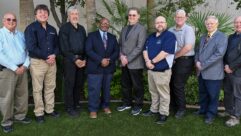One of his cluster’s program directors asked Bruce Roberts, director of engineering for Apex Broadcasting in Charleston, S.C., to build a “shot clock” like the one used in basketball. The PD wanted to allow studio talent to have a big display showing how long they were talking.

Fig. 1: Bruce Roberts uses a large 2-1/4-inch clock module to time talk segments. In the old days, many clocks would count seconds only if you held the correct sequence of Set pushbuttons. Bruce found that clocks sold today use a programmable Peripheral Interface Controller. The PIC tells the clock and the buttons what to do.
So he and his staff ordered a clock module from the Velleman Store, as shown in Fig. 1. It’s a large 2-1/4-inch clock display (www.vellemanstore.com/en, search for part K8089).
With the help of a PIC programmer and experiment board, also from Velleman (part K8048), Bruce’s head IT guy, Andy Power, rewrote the PIC code — written in MPlab — to make the clock count up in seconds; and at the four-minute mark it will begin to flash, to alert the talent that they are over time for the segment.
Andy was able to program one of the clock buttons to start the timer count running, and when released, it will hold time for that segment until the button is pressed again. If tied to the control room on-air light controller, operation is automatic and resets each time the microphone is turned on. Andy decided to use the jumpers on the clock to provide the option of beginning the flash at 1, 2, 3, 4 or 5 minutes, depending on the jumper setting.

Fig. 2: The screwdriver blade points to the PIC, which controls the clock. The screwdriver blade in Fig. 2 points to the PIC chip.
The large clock module costs $89.95; the PIC programmer and experimenter board is just $24.95.
A countdown clock like this helps the talent stay on schedule. This is a nice feature to offer your PD, especially if you run a talk/music morning show.
Thanks, Bruce and Andy, for sharing this great idea.
***
Workbench readers have turned into super-sleuths. We’re going to have to find some older studio photographs to challenge you further!
Read Burgan is the latest to write in about the earlier studio photo we shared. He said it is remotely possible that the photo was from 1967, but unlikely. Why? The tape recorder in the photo is almost certainly an Ampex AG-600, the transistorized two-speed version of that model; it didn’t come out until 1967. The station might have purchased one the first year it was introduced, but it is more likely that the photo was later than that.
***
Project Engineer Dan Slentz, a fellow RW contributor, writes in with some sad news. The FCC no longer routinely issues paper license documents to amateur radio applicants and licensees. The commission maintains that the official amateur radio license authorization is the electronic record that exists in its Universal Licensing System, although the FCC routinely had continued to print and mail hard copy licenses until the middle of February.
The commission will continue to provide paper license documents to licensees who notify it that they prefer one. Otherwise, licensees will be able to print out an official authorization — as well as an unofficial “reference copy” — from the ULS License Manager.
***
Crawford Broadcasting Director of Engineering Cris Alexander, another Radio World veteran, passes along a reminder for AM directionals.
Stations using Method of Moment sample systems may need to perform a biennial recertification in the coming months. This is one of those measurements, like the annual occupied bandwidth measurements, that can be overlooked.
Cris wrote a thorough article reviewing this topic in February 2014 titled “Don’t Forget Those Recertification Measurements.” Visit radioworld.com and enter “recertification measurements” in the search field.
Contribute to Workbench. You’ll help your fellow engineers and qualify for SBE recertification credit. Send Workbench tips to [email protected]. Fax to (603) 472-4944.
Author John Bisset has spent 45 years in the broadcasting industry and is still learning. He handles West Coast sales for the Telos Alliance. He is SBE Certified and is a past recipient of the SBE’s Educator of the Year Award.











